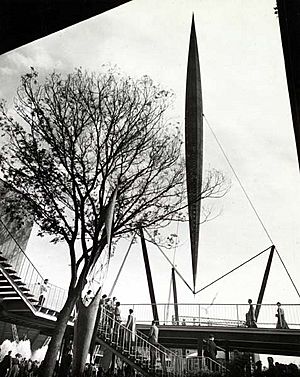Skylon (Festival of Britain) facts for kids

The Skylon was a tall, thin, cigar-shaped tower built for the Festival of Britain in 1951. It was made of steel and stood next to the River Thames in London. The way it was built made it look like it was floating above the ground! People often joked that it had "no visible means of support."
Contents
Building the Skylon
The Skylon was a very important symbol of the Festival of Britain. It was designed by Hidalgo Moya, Philip Powell, and Felix Samuely. The tower was put together on the South Bank of London, between Westminster Bridge and Hungerford Bridge.
How was it built?
The Skylon had a steel frame that looked like a net. It was pointed at both ends. Strong cables held it up between three steel beams. The tower was built piece by piece, growing taller as it was put together. The base of the Skylon was about 15 meters (50 feet) off the ground. Its very top reached almost 90 meters (300 feet) high! The frame was covered with aluminum strips. At night, lights inside made it glow.
People in Parliament even worried about lightning hitting the Skylon. News reports said it was sometimes roped off when thunderstorms were expected.
What does the name "Skylon" mean?
The name "Skylon" was suggested by Mrs. A. G. S. Fidler. The designers liked it because it combined ideas from "Pylon" (a tall structure), "Sky," and "Nylon" (a new and exciting material back then). It was a perfect name for the tower that seemed to touch the sky!
Why was the Skylon taken down?
Even though many people loved the Skylon, it cost a lot to move it. The government decided it was too expensive to take it apart and rebuild it somewhere else. This was because Britain was still recovering from World War II.
So, the Skylon was taken down in 1952. This happened when the rest of the Festival of Britain was also removed. Winston Churchill, who was the Prime Minister, ordered it to be taken down. He saw the Festival as a symbol of the previous government's ideas for Britain.
What happened to the Skylon's parts?
For a long time, no one was sure what happened to the Skylon. Some people thought it was thrown into a river or buried. But a radio show found out the truth! The Skylon was sold to a company that deals with scrap metal. They took it apart at their works in Canning Town.
Some small pieces of the metal were even made into special paper-knives and other souvenirs. These items had words on them saying they were "Made from the aluminium alloy roof sheets which covered the Dome of Discovery at the Festival of Britain." The Dome of Discovery was another building at the Festival.
Today, the base of the Skylon is kept safe at the Museum of London. Some other parts are in a private collection. The spot where the Skylon once stood is now a walking area. It is between the London Eye and Hungerford Bridge, next to the Jubilee Gardens.
Skylon Restaurant
In 2007, a new restaurant opened in the Royal Festival Hall called "Skylon." It was named after the famous tower. This restaurant used to be called The Peoples Palace.
Images for kids





